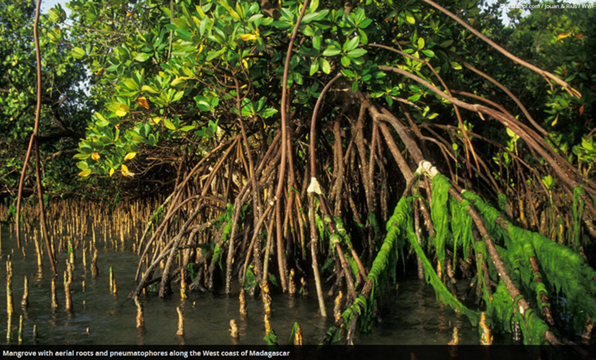Rainforests are cited often for storing carbon in the ground and preventing release of CO2 into the atmosphere. Yet, what appears to earn a lot less attention are mangroves – groups of trees and shrubs that live in coastal intertidal zones (National Ocean Service).
 You may have seen these beautiful trees while kayaking in Florida, or perhaps you’ve been to Texas or any of the Gulf states along the shoreline. The roots of mangroves are very intricate, giving them the appearance of floating in the water. Their ability to live in salt water and withstand high tides can protect coastal lands from erosion and storm surges, a crucial barrier for areas with flooding and hurricanes.
You may have seen these beautiful trees while kayaking in Florida, or perhaps you’ve been to Texas or any of the Gulf states along the shoreline. The roots of mangroves are very intricate, giving them the appearance of floating in the water. Their ability to live in salt water and withstand high tides can protect coastal lands from erosion and storm surges, a crucial barrier for areas with flooding and hurricanes.
But the coolest aspect of Mangroves is their amazing carbon-capturing capabilities as well as the habitats they protect. According to the National Ocean Service, “mangroves and coastal wetlands annually sequester carbon at a rate ten times greater than mature tropical forests.” Coastal blue carbon also includes salt marshes and seagrass meadows.
Despite the amazing capabilities of mangroves, these water trees and shrubs are declining at a rapid rate due to overdevelopment along coastal shorelines from commercial ports. When mangroves are destroyed, all the carbon that was captured in the soil is now released into the atmosphere, adding to greenhouse gas emissions.
Groups like the World Wildlife Fund (WWF) are dedicated to protecting and restoring mangroves in Fiji, Mexico, Colombia, and Madagascar. Check out their campaign to save them here!
References
https://oceanservice.noaa.gov/ecosystems/coastal-blue-carbon/
https://www.worldwildlife.org/stories/mangroves-as-a-solution-to-the-climate-crisis
Written by:

Jaclyn DiDonato
Environmental Sustainability Associate
Whitman Green Team Leader
Posted on February 23rd, 2024





